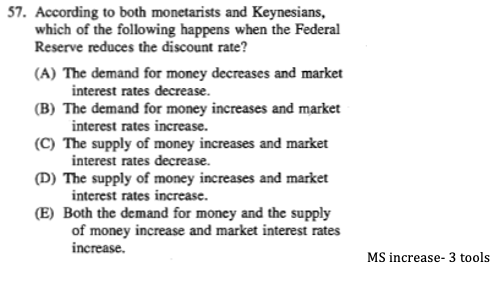Federal Reserve - Central Bank - Monetary Policy
Past AP Exam (Released) Questions
Multiple Choice Review
(A) Keep part of their demand deposits as reserves
(E) The Discount Rate - The rate of Interest that the FED charges banks
when they borrow from the FED
(FED2Bank Loans)
(D) Business purchase more factories & equip
RRR decreases-MS increases-Nominal Interest rate decreases-Investment increase
Investment = More loans taken out to create capital goods - factories, equipment, tools etc
(E) Banks less able to extend credit
If people's DM increases then they want more money in their poskets and less money in the banks - If the banks have less money they have less ability to extend loans
also if there is less money in the banks the NIR will increase and less people will
take out loans for investment purposes.
(Below full employment level of output) = Recession
(D) open market purchases of bonds
(D) MS increases and market (nominal) Interest Rate decreases)
(B) bank charge one another for short-term loans
FED Funds Rate = (Bank2Bank Loans)
(E) Fed buys gov't bonds
As the Fed Buys Bonds the MS increases and the Nominal Interest rate decreases
Lower nominal rates = lower rates that banks can charge one another
therefore lower Federal Funds rates
If you only have the categories of
Required Reserves & Excess Reserves
Then Req. Res. & Exc. Res. must = Checkable Deposits
$45 must be in Required Reserves & $45 is 15% of $300
(B) Increase by $200 - Increase by $30
$200 is deposited in Checkable deposits
the RR is 15%
15% of the $200 goes into the Req. Res. = $30
the rest ($170) flows into Exc Res.
What is in Excess Reserves can be loaned out
(C) $3,000
Anytime the College Board gives you (Total Reserves or Reserves)
you must figure out the required and the excess
they are trying to trick you - the jerks!
(D) $9,000
(D) $500
RRR = 20%
Money Multiplier = 1/RRR = 5
Banks Loan out money from Excess Reserves increases the Money Supply
$100 in excess reserves x 5 = $500 increase in the Money Supply
(B) $900
$100 in Check Dep.
RRR = 10% therefore $10 in Req Res.
$90 flows into Excess Res.
Banks loan out all of their Exc Res.
Money Multiplier = 1/RRR = 1/.1 = 10
$90 x 10 = MS increases by $900
(B) less than $5 million
** Notice in the question (A $1 million increase in Reserves)
If the full $1million was in excess reserves
and it all was loaned out.
The Money Multiplier = 1/RRR = 1/.2 = 5
$1million x 5 = 5 million increase in money supply
but
The problem said: banks voluntarily keep some excess reserves.
If banks loan out less than the $1 million in exc. res. then the money supply can't increase by the full $5 million
(C) $2,000 billion
** Tricky tricky question
Recognize that when the FED buys bonds the MS increases by $400b immediately
Then when citizens deposit that $400b in the banks the money supply
increases again when banks loan out money
Exc Res. = $320 x 5 = $1,600 increase in the MS
Therefore $1,600 Bank increased MS
+ $400 FED increased MS
= $2,000 total increase in MS
(C) $900
(E) Decrease of $5 million
Selling Bonds is Contrationary - MS will decrease
RRR = 20% = Money Multiplier = 1/.2 = 5
$1 million sold bonds = $1m x 5 = $5 million decrease in MS


































No comments:
Post a Comment